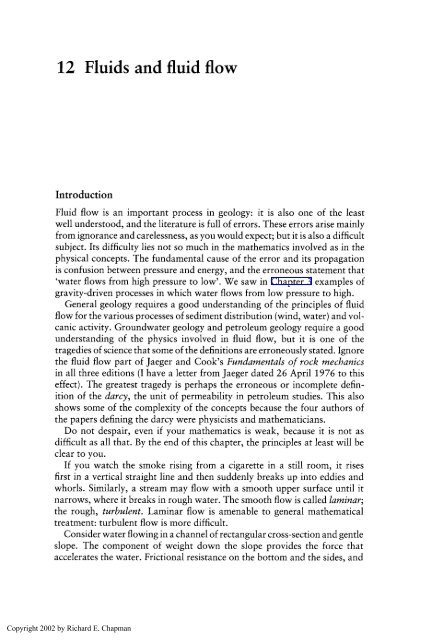Physics for Geologists, Second edition
Physics for Geologists, Second edition
Physics for Geologists, Second edition
You also want an ePaper? Increase the reach of your titles
YUMPU automatically turns print PDFs into web optimized ePapers that Google loves.
12 Fluids and fluid flow<br />
Introduction<br />
Fluid flow is an important process in geology: it is also one of the least<br />
well understood, and the literature is full of errors. These errors arise mainly<br />
from ignorance and carelessness, as you would expect; but it is also a difficult<br />
subject. Its difficulty lies not so much in the mathematics involved as in the<br />
physical concepts. The fundamental cause of the error and its propagation<br />
is confusion between pressure and energy, and the erroneous statement that<br />
'water flows from high pressure to low'. We saw in Chapter 3 examples of<br />
gravity-driven processes in which water flows from low pressure to high.<br />
General geology requires a good understanding of the principles of fluid<br />
flow <strong>for</strong> the various processes of sediment distribution (wind, water) and vol-<br />
canic activity. Groundwater geology and petroleum geology require a good<br />
understanding of the physics involved in fluid flow, but it is one of the<br />
tragedies of science that some of the definitions are erroneously stated. Ignore<br />
the fluid flow part of Jaeger and Cook's Fundamentals of rock mechanics<br />
in all three <strong>edition</strong>s (I have a letter from Jaeger dated 26 April 1976 to this<br />
effect). The greatest tragedy is perhaps the erroneous or incomplete defin-<br />
ition of the darcy, the unit of permeability in petroleum studies. This also<br />
shows some of the complexity of the concepts because the four authors of<br />
the papers defining the darcy were physicists and mathematicians.<br />
Do not despair, even if your mathematics is weak, because it is not as<br />
difficult as all that. By the end of this chapter, the principles at least will be<br />
clear to you.<br />
If you watch the smoke rising from a cigarette in a still room, it rises<br />
first in a vertical straight line and then suddenly breaks up into eddies and<br />
whorls. Similarly, a stream may flow with a smooth upper surface until it<br />
narrows, where it breaks in rough water. The smooth flow is called laminar;<br />
the rough, turbulent. Laminar flow is amenable to general mathematical<br />
treatment: turbulent flow is more difficult.<br />
Consider water flowing in a channel of rectangular cross-section and gentle<br />
slope. The component of weight down the slope provides the <strong>for</strong>ce that<br />
accelerates the water. Frictional resistance on the bottom and the sides, and<br />
Copyright 2002 by Richard E. Chapman






